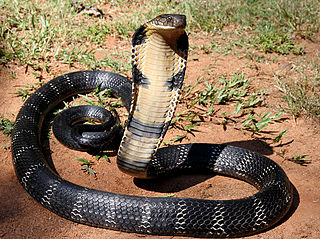
The king cobra is a venomous snake endemic to Asia. The sole member of the genus Ophiophagus, it is not taxonomically a true cobra, despite its common name and some resemblance. With an average length of 3.18 to 4 m and a record length of 5.85 m (19.2 ft), it is the world's longest venomous snake. The species has diversified colouration across habitats, from black with white stripes to unbroken brownish grey. The king cobra is widely distributed albeit not commonly seen, with a range spanning from the Indian Subcontinent through Southeastern Asia to Southern China. It preys chiefly on other snakes, including those of its own kind. This is the only ophidian that constructs an above-ground nest for its eggs, which are purposefully and meticulously gathered and protected by the female throughout the incubation period.

The short-toed snake eagle, also known as the short-toed eagle, is a medium-sized bird of prey in the family Accipitridae, which also includes many other diurnal raptors such as kites, buzzards and harriers. The genus name Circaetus is from the Ancient Greek kirkos, a type of hawk, and aetos, "eagle". The specific gallicus means "of Gallia".

Paucituberculata is an order of South American marsupials. Although currently represented only by the seven living species of shrew opossums, this order was formerly much more diverse, with more than 60 extinct species named from the fossil record, particularly from the late Oligocene to early Miocene epochs. The earliest paucituberculatans date to the late Paleocene. The group went through a pronounced decline in the middle Miocene epoch, which resulted in the extinction of all families of this order except for the living shrew opossums (Caenolestidae). Extinct families of Paucituberculatans include Pichipilidae, Palaeothentidae, and Abderitidae.

Coral snakes are a large group of elapid snakes that can be divided into two distinct groups, the Old World coral snakes and New World coral snakes. There are 27 species of Old World coral snakes, in three genera, and 83 recognized species of New World coral snakes, in two genera. Genetic studies have found that the most basal lineages have origins in Asia, suggesting that the group originated in the Old World. While new world species of both genera are venomous, their bites are seldom lethal; only two confirmed fatalities have been documented in the past 100 years from the genus Micrurus. Meanwhile, snakes of the genus Micruroides have never caused a medically significant bite.

Natrix is a genus of Old World snakes found mainly across Eurasia in the subfamily Natricinae of the family Colubridae. They are commonly called grass snakes and water snakes, but some other snake species also known commonly as "grass snakes" and "water snakes" are not in the genus.

Metailurus is a genus of saber-toothed cat in the family Felidae, and belonging to the tribe Metailurini, which occurred in North America, Eurasia and Africa from the Miocene to the Middle Pleistocene.
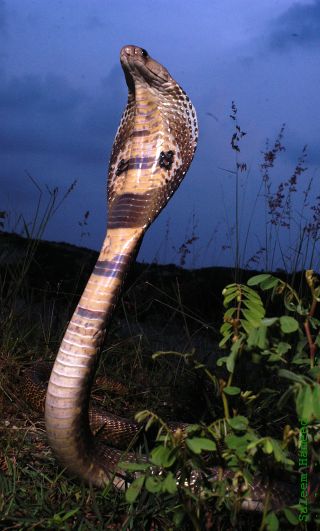
The Indian cobra, also known commonly as the spectacled cobra, Asian cobra, or binocellate cobra, is a species of cobra, a venomous snake in the family Elapidae. The species is native to the Indian subcontinent, and is a member of the "big four" species that are responsible for the most snakebite cases in India.

The Caspian cobra, also called the Central Asian cobra, ladle snake, Oxus cobra, or Russian cobra, is a species of highly venomous snake in the family Elapidae. The species is endemic to Central Asia. Described by Karl Eichwald in 1831, it was for many years considered a subspecies of the Indian cobra until genetic analysis revealed it to be a distinct species.

Naja is a genus of venomous elapid snakes commonly known as cobras. Members of the genus Naja are the most widespread and the most widely recognized as "true" cobras. Various species occur in regions throughout Africa, Southwest Asia, South Asia, and Southeast Asia. Several other elapid species are also called "cobras", such as the king cobra and the rinkhals, but neither is a true cobra, in that they do not belong to the genus Naja, but instead each belong to monotypic genera Hemachatus and Ophiophagus.

The many-banded snake, also known commonly as the burrowing cobra, is a species of venomous snake in the family Elapidae. The species is native to Central Africa. There are three recognized subspecies.
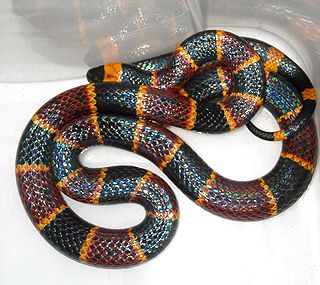
Micrurus fulvius, commonly known as the eastern coral snake, common coral snake, American cobra, and more, is a species of highly venomous coral snake in the family Elapidae. The species is endemic to the southeastern United States. It should not be confused with the scarlet snake or scarlet kingsnake, which are harmless mimics. No subspecies are currently recognized.

Micrurus hemprichii, commonly known as Hemprich's coral snake and the worm-eating coral snake, is a species of venomous coral snake in the family Elapidae. The species is native to South America.
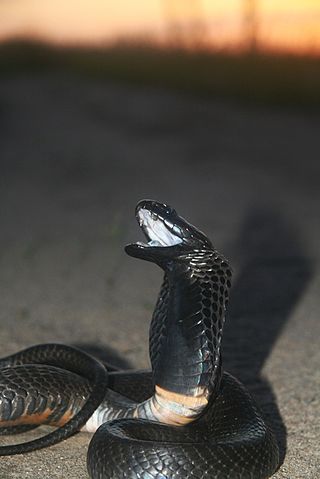
The black-necked spitting cobra is a species of spitting cobra found mostly in sub-Saharan Africa. They are moderately sized snakes that can grow to a length of 2.2 to 3.0 m in length. Their coloration and markings can vary considerably. They prey primarily on small rodents. They possess medically significant venom, although the mortality rate for untreated bites on humans is relatively low. Like other spitting cobras, they can eject venom from their fangs when threatened. The neurotoxic venom irritates the skin, causing blisters and inflammation, and can cause permanent blindness if the venom makes contact with the eyes and is not washed off.

The forest cobra, also commonly called the black cobra and the black and white-lipped cobra, is a species of highly venomous snake in the family Elapidae. The species is native to Africa, mostly the central and western parts of the continent. It is the largest true cobra species with a record length of 3.2 metres.

Micrurus nigrocinctus, commonly known as the Central American coral snake, is a species of a highly venomous snake in the family Elapidae. The species is endemic to Latin America from southern Mexico, Central America, to north Colombia. There are six recognized subspecies, including the nominate subspecies described here.

The Equatorial spitting cobra also called the Malayan spitting cobra, golden spitting cobra, Sumatran spitting cobra, or Palawan spitting cobra, is a species of spitting cobra found in Southeast Asia.
Promacrauchenia is an extinct genus of macraucheniids that lived during the Late Miocene to Late Pliocene epochs of what is now Argentina and Bolivia. It belongs to the subfamily Macraucheniinae, which also includes Huayqueriana, Macrauchenia, and Xenorhinotherium. Fossils of this genus have been found in the Ituzaingó, Andalhuala, and Cerro Azul Formations of Argentina.
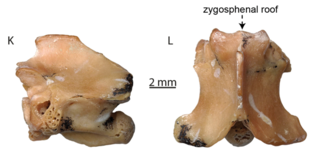
Naja romani is an extinct species of cobra from the Miocene of Europe. Its remains have been found from France to Russia and suggest a continued growth to larger sizes throughout its range in time. While successful during the early and middle stages of the Miocene, the species disappeared from the fossil record of Central Europe during the late Miocene with the last known specimen being recovered from a site in the modern Caucasus, inferred to have been a refuge for reptiles. Estimates suggest that Naja romani may have reached a length of over 2 m.
















